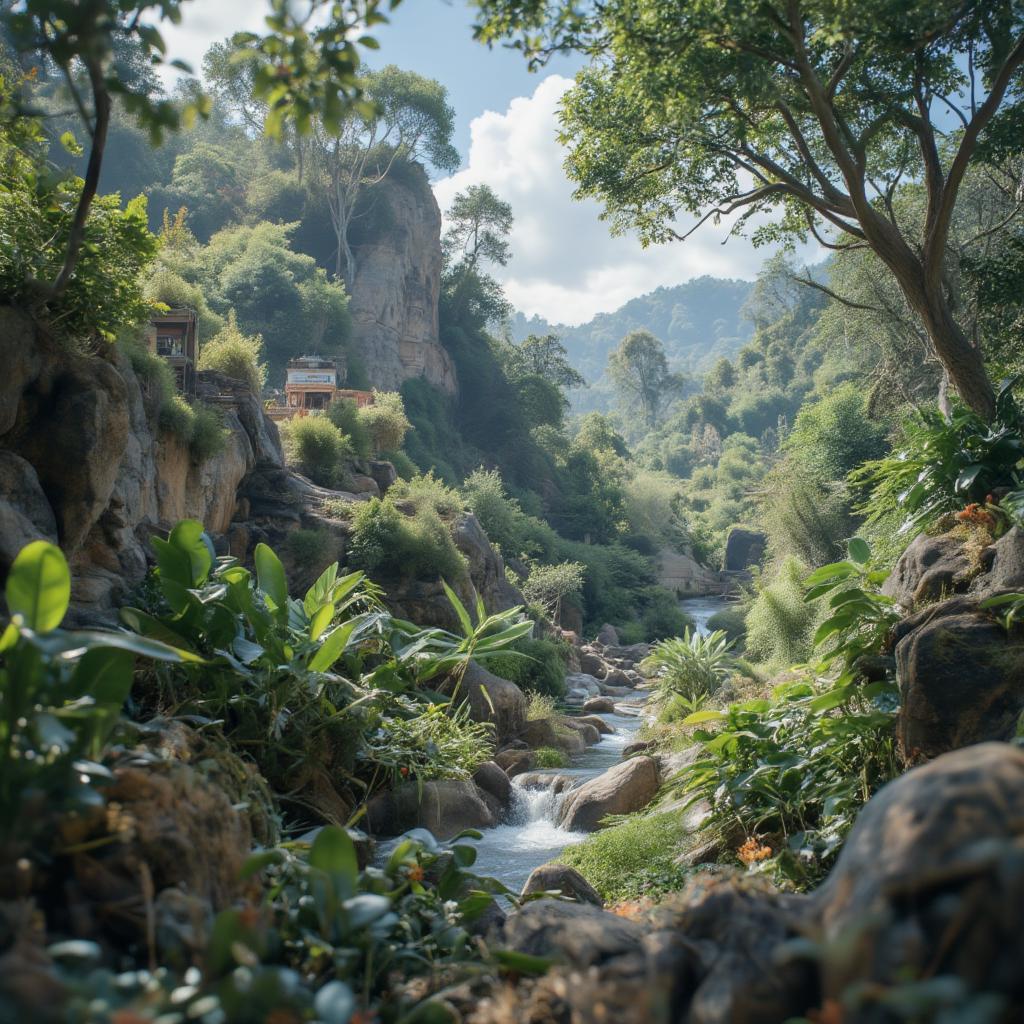Unveiling The Lost City of Z: An Exploration into Amazonian Mysteries

The allure of the unknown has always captivated the human spirit, and few mysteries are as compelling as the legend of The Lost City Of Z. This enigmatic civilization, rumored to reside deep within the Amazon rainforest, continues to ignite the imaginations of explorers, historians, and dreamers alike. But what exactly fuels this fascination, and what truth, if any, lies behind the whispers?
The Genesis of a Myth: Percy Fawcett’s Obsession
Our journey into the mystery begins with the figure of Percy Fawcett, a British explorer and geographer whose name is now inextricably linked with the Lost City of Z. In the early 20th century, Fawcett became convinced that a highly advanced civilization, distinct from known Indigenous cultures, had once flourished in the Amazon. Fueled by ancient maps, conquistador accounts, and his own experiences, Fawcett embarked on several expeditions to uncover the truth. He envisioned a city of immense scale and sophistication, a place he dubbed simply “Z.”
- Fawcett’s belief was not merely based on conjecture; he had a rationale for his theory.
- He meticulously analyzed historical texts and Indigenous lore, seeking to validate the existence of “Z”.
- He was a skilled surveyor and cartographer, documenting every detail of his explorations.
“My explorations of the Amazon are not merely about mapping territory,” remarked Professor Evelyn Reed, a specialist in Amazonian history at the University of Cambridge, “but also about understanding the cultures and civilizations that may have thrived long before our time.” Professor Reed’s comment speaks volumes about the spirit that drove Fawcett, and that continues to motivate those who search for the lost city of Z.

The Ill-Fated 1925 Expedition
Fawcett’s final expedition, launched in 1925, remains shrouded in mystery. Accompanied by his eldest son, Jack, and a friend, Raleigh Rimell, Fawcett vanished without a trace into the uncharted depths of the Mato Grosso region of Brazil. Despite numerous attempts to locate them, and to uncover what truly happened, they have never been seen again.
- The mystery surrounding their disappearance has only fueled the legend of Z, adding to its allure.
- Various theories have emerged to explain their fate: attacks by hostile tribes, natural disasters, or even deliberate disappearances.
- The lack of concrete evidence has allowed speculation to run wild.
What is the Lost City of Z? Fact or Fiction?
The question remains: Is the Lost City of Z a tangible historical reality or simply a figment of imagination, fueled by adventure stories and misinterpretations? While no definitive proof of a large, sophisticated city in the style Fawcett envisioned has been found, compelling archeological evidence suggests that the Amazon was not as uninhabited as previously thought.
Pre-Columbian Amazonian Civilizations: New Discoveries
Recent archeological findings have revealed the existence of sophisticated pre-Columbian societies that thrived in the Amazon for centuries. These civilizations, far from being simple hunter-gatherers, engaged in agriculture, large-scale earthworks, and complex social structures. Evidence includes:
- Geoglyphs (large earth drawings) discovered in the deforested areas, indicating a complex understanding of geometry and agriculture.
- Remnants of large settlements with engineered roads, drainage systems, and canals suggest a highly organized society.
- Findings of ceramics and other artifacts that suggest trade networks.
The discovery of these complex societies adds further fuel to debate surrounding the Lost City of Z.
“The sheer scale of these Amazonian archaeological finds is staggering,” Dr. Anya Sharma, a leading archaeologist specializing in Amazonian cultures at the Smithsonian Institute, notes. “These civilizations, while different from Fawcett’s vision, prove that the Amazon was far more densely populated and advanced than we once thought.” Her statement highlights a shift in perception of historical narratives regarding this region.
The Search Continues: Modern Expeditions and Technologies
Today, the quest for the Lost City of Z continues, although with modern tools and techniques. Advanced mapping technologies, satellite imagery, and ground-penetrating radar are used to uncover hidden settlements, buried ruins, and evidence of past civilizations. Scientists and explorers are more focused on uncovering what civilizations did exist rather than seeking a single legendary city.
- Technological advancements provide a less hazardous means of exploration.
- Modern approaches emphasize collaboration with indigenous communities and respecting their knowledge.
- The focus has shifted towards understanding the ecological and cultural context of ancient Amazonia.
Are We Looking for the Right Thing?
Perhaps, the idea of a “Lost City of Z” as a single, opulent city is misleading. It might be that Fawcett’s vision was shaped by European expectations. Instead, the truth may lie in a network of connected communities, smaller settlements, and a complex ecosystem managed and modified by these societies.
The Enduring Fascination of Z: Why It Captures Our Imagination
Despite the absence of definitive evidence, the legend of the Lost City of Z continues to capture the imagination. Its appeal transcends archeology and history, tapping into deep-seated human desires for exploration, discovery, and the allure of the unknown. The story resonates with themes of:
- Adventure and the search for hidden truths
- The challenge of the natural world and the triumph of the human spirit
- The potential for finding what is deemed impossible
- Mystery surrounding ancient civilizations and their secrets
- Reflections on the relationship between humans and the environment
The Lost City of Z serves as a metaphor for that which is yet to be discovered, both in the world around us and within ourselves.

“The Amazon is a vast and complex environment, filled with secrets both geological and historical,” states Dr. Kenji Tanaka, a lead researcher in satellite archaeology at Tokyo University. “The story of the Lost City of Z serves as an important reminder of the importance of preservation and understanding our past.” His comment serves as an appropriate reminder that the search for Z has more layers than just history.
Conclusion: The Journey of Discovery Continues
While the exact nature of the Lost City of Z may still elude us, the search itself has driven a remarkable journey of discovery. It has prompted us to reassess our understanding of the Amazonian past, shedding light on ancient civilizations and their remarkable achievements. The legend of the Lost City of Z embodies the eternal human quest for knowledge and the relentless pursuit of the unknown. Whether the city ever truly existed or not, the spirit of adventure and discovery that it represents will continue to inspire generations to come. The search for the Lost City of Z is as much a journey into the depths of human curiosity as it is a literal exploration of the Amazonian rainforest.
FAQ: Unveiling The Mysteries of The Lost City of Z
What sparked Percy Fawcett’s interest in the Lost City of Z?
Fawcett was intrigued by ancient maps, conquistador stories, and local legends which suggested a sophisticated city was hidden in the Amazonian jungle. He thought these sources were evidence of “Z”, a civilization that predated known cultures.
Has the Lost City of Z ever been found?
Despite many searches, there has been no proof found of the specific “Lost City of Z” that Fawcett envisioned. However, archeological discoveries have shown the Amazon was home to sophisticated, previously unrecognized, civilizations.
What evidence suggests that ancient civilizations existed in the Amazon?
Recent discoveries like geoglyphs, large settlements, complex earthworks and infrastructure, plus advanced tools indicate thriving pre-Columbian societies that were more complex than previously believed. These archeological facts point to an Amazon more populated than historical narratives indicated.
What happened to Percy Fawcett during his final expedition?
Fawcett and his team vanished in 1925 while exploring the Mato Grosso region of Brazil. Despite many search attempts, their fate remains unknown. Various theories point to attacks by tribes, accidents or getting lost.
How is the search for the Lost City of Z continuing today?
Modern expeditions use technology such as satellite imagery, ground-penetrating radar, and collaborate with indigenous communities. Focus has now shifted to understand the complex history of civilization in the Amazon, not just finding one city.
Why does the Lost City of Z continue to fascinate so many people?
The legend touches upon many powerful themes: mystery, the unknown, adventure, and the human spirit’s desire to explore. It also serves as a metaphor for all discoveries that are waiting to be made.
What is the significance of the new archaeological finds in the Amazon?
The finds reveal a more complex and sophisticated pre-Columbian presence than previously believed. This challenges previously held views of the Amazon as sparsely populated, and it provides insights into the skills and ingenuity of ancient people.
What are some of the main challenges in searching for the Lost City of Z?
The Amazon rainforest’s vastness, dense vegetation, difficult terrain, and lack of modern infrastructure all create difficulties. Plus, the mystery surrounding Fawcett’s expedition further complicates the search.
Are there any ethical considerations when searching for the Lost City of Z?
Yes. It’s important to consider the impact on the local environment and indigenous communities. Collaborative methods with the participation of the locals are crucial. The importance of preserving both the archaeological sites and environment is paramount.




